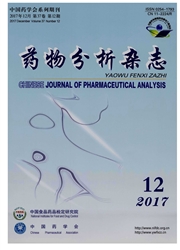

 中文摘要:
中文摘要:
目的:建立大鼠灌胃银杏叶提取物后血浆中黄酮类成分的灵敏分析方法,并进行药代动力学研究。方法:血浆样品经葡萄糖醛酸苷水解酶水解后,采用高效液相色谱分离及电化学检测,同时分析大鼠血浆样品中槲皮素、异鼠李素和山柰酚。色谱柱为Agilent Zorbax Ec lipse XDB-C8(150 mm×4.6 mm,5μm),流动相为甲醇-异丙醇-磷酸盐缓冲液(磷酸二氢钠-磷酸,pH=2)(15?15?70),流速0.8 mL.m in-1,检测电压为200 mV,柱温30℃。结果:槲皮素、异鼠李素和山柰酚与其他内源性和药源性成分达到良好分离;最低检测浓度达到0.5 ng.mL-1;平均提取回收率分别为88.7%,86.2%,87.0%;准确度在92.7%~105.3%之间,日内精密度RSD小于6.6%,日间精密度RSD小于14.1%,样品分析时间为20 m in。大鼠灌胃给予银杏叶提取物10 mg.kg-1后,酶水解血浆中槲皮素、异鼠李素和山柰酚的半衰期分别为(3.53±1.88)h,(6.94±4.05)h,(3.97±2.30)h;3个黄酮类成分在大鼠血浆中都显示明显的二次达峰现象。结论:建立的检测方法能灵敏、特异、准确,可用于银杏叶提取物灌胃给药后黄酮类成分的药代动力学研究。
 英文摘要:
英文摘要:
Objective:To establish a sensitive method for the quantification of flavonols from rat plasma after intragastric administration of Ginkgo biloba leaf extracts.Methods:HPLC with electrochemical detection(ECD) was employed to quantify quercetin,isorhamnetin and kaempferol simultaneously after plasma samples were hydrolyzed by glucuronidase.The sample was separated by Agilent Zorbax Eclipse XDB-C8(150 mm×4.6 mm,5 μm) column and eluted by the mobile phase composed of methanol-isopropanol-phosphate buffer(NaH2PO4-H3PO4,pH=2)(15∶15∶70) at column temperature of 30 ℃,and the flow rate was 0.8 mL·min-1.The potential of analysis cell was selected as 200 mV.Results:The analysis of plasma samples could be performed in 20 min with the quantitative limit of 0.5 ng·mL-1 and average recovery of 88.7%,86.2% and 87.0% for quercetin,isorhamnetin and kaempferol,respectively.The intra-and inter-day precision(RSD) was measured less than 6.6% and 14.1%,meanwhile the accuracy was calculated as 92.7%-105.3%.The concentration-time data after oral administration of 10 mg·kg-1 Ginkgo biloba leaf extracts showed that flavanols was absorbed rapidly and presenting the fist peak appeared at 0.17-0.23 h and the second peak at 6 h.The elimination half-life time(t1/2k) was calculated as(3.53±1.88) h,(6.94±4.05) h and(3.97±2.30) h for quercetin,isorhamnetin and kaempferol,respectively.Conclusion:The method developed in the present study using HPLC-ECD is highly sensitive,accurate,rapid and suitable for pharmacokinetic study of Ginkgo biloba leaf extracts in rats.
 同期刊论文项目
同期刊论文项目
 同项目期刊论文
同项目期刊论文
 Pro-angiogenic actions of Salvianolic acids on in vitro cultured endothelial progenitor cells and ch
Pro-angiogenic actions of Salvianolic acids on in vitro cultured endothelial progenitor cells and ch Effects and Mechanism of Weinaokang (sic) on Reperfusion-induced Vascular Injury to Cerebral Microve
Effects and Mechanism of Weinaokang (sic) on Reperfusion-induced Vascular Injury to Cerebral Microve Herbal Extracts Combination (WNK) Prevents Decline in Spatial Learning and Memory in APP/PS1 Mice th
Herbal Extracts Combination (WNK) Prevents Decline in Spatial Learning and Memory in APP/PS1 Mice th 期刊信息
期刊信息
